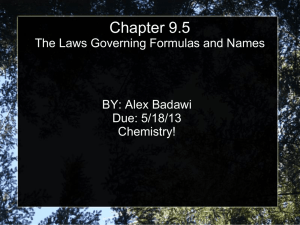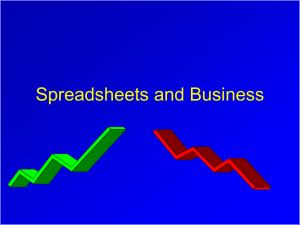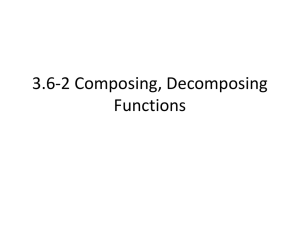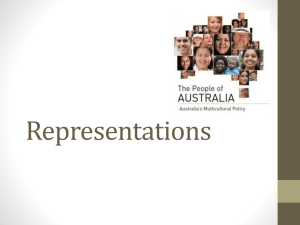- PhilSci
advertisement
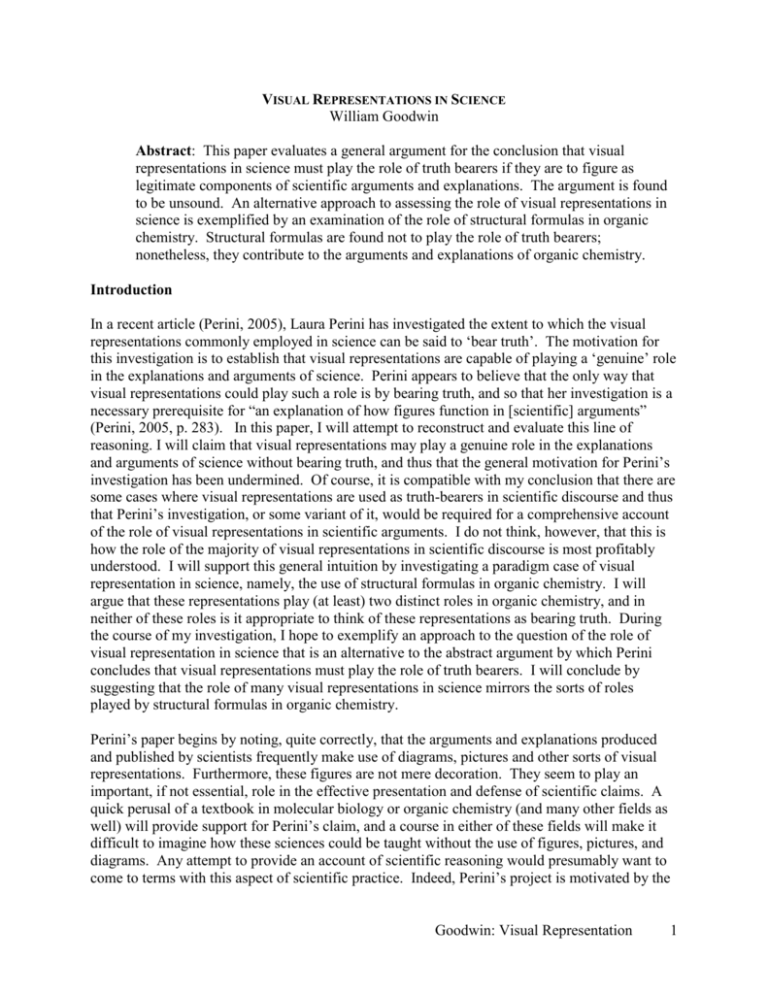
VISUAL REPRESENTATIONS IN SCIENCE William Goodwin Abstract: This paper evaluates a general argument for the conclusion that visual representations in science must play the role of truth bearers if they are to figure as legitimate components of scientific arguments and explanations. The argument is found to be unsound. An alternative approach to assessing the role of visual representations in science is exemplified by an examination of the role of structural formulas in organic chemistry. Structural formulas are found not to play the role of truth bearers; nonetheless, they contribute to the arguments and explanations of organic chemistry. Introduction In a recent article (Perini, 2005), Laura Perini has investigated the extent to which the visual representations commonly employed in science can be said to ‘bear truth’. The motivation for this investigation is to establish that visual representations are capable of playing a ‘genuine’ role in the explanations and arguments of science. Perini appears to believe that the only way that visual representations could play such a role is by bearing truth, and so that her investigation is a necessary prerequisite for “an explanation of how figures function in [scientific] arguments” (Perini, 2005, p. 283). In this paper, I will attempt to reconstruct and evaluate this line of reasoning. I will claim that visual representations may play a genuine role in the explanations and arguments of science without bearing truth, and thus that the general motivation for Perini’s investigation has been undermined. Of course, it is compatible with my conclusion that there are some cases where visual representations are used as truth-bearers in scientific discourse and thus that Perini’s investigation, or some variant of it, would be required for a comprehensive account of the role of visual representations in scientific arguments. I do not think, however, that this is how the role of the majority of visual representations in scientific discourse is most profitably understood. I will support this general intuition by investigating a paradigm case of visual representation in science, namely, the use of structural formulas in organic chemistry. I will argue that these representations play (at least) two distinct roles in organic chemistry, and in neither of these roles is it appropriate to think of these representations as bearing truth. During the course of my investigation, I hope to exemplify an approach to the question of the role of visual representation in science that is an alternative to the abstract argument by which Perini concludes that visual representations must play the role of truth bearers. I will conclude by suggesting that the role of many visual representations in science mirrors the sorts of roles played by structural formulas in organic chemistry. Perini’s paper begins by noting, quite correctly, that the arguments and explanations produced and published by scientists frequently make use of diagrams, pictures and other sorts of visual representations. Furthermore, these figures are not mere decoration. They seem to play an important, if not essential, role in the effective presentation and defense of scientific claims. A quick perusal of a textbook in molecular biology or organic chemistry (and many other fields as well) will provide support for Perini’s claim, and a course in either of these fields will make it difficult to imagine how these sciences could be taught without the use of figures, pictures, and diagrams. Any attempt to provide an account of scientific reasoning would presumably want to come to terms with this aspect of scientific practice. Indeed, Perini’s project is motivated by the Goodwin: Visual Representation 1 desire to make room for an account of scientific discourse that takes its visual aspects seriously. Rather than consigning such visual representations to a merely heuristic role, she wants to understand them as full-fledged components of scientific arguments, explanations and descriptions. Worries arise when one tries to accommodate the empirical fact that visual representations play an important role in scientific practice within philosophical accounts of the nature of explanations and/or arguments. Arguments are -- paradigmatically at least --sequences of claims. These sequences begin with premises independently acknowledged or argued for and then proceed by steps recognized, either explicitly or implicitly, as legitimate (e.g. truth preserving) to the conclusion of the argument. The components of such sequences are expressions capable of being true or false, or to use Perini’s language, capable of ‘bearing truth’. Similarly, while scientific explanations have been analyzed in a variety of ways, they are also typically understood as claims or sequences of claims. For example, according to most nomological models of explanation a scientific explanation is an argument, while according to erotetic models an explanation is an assertion that answers a particular question. Either way, the components of scientific explanations seem to be claims. As a result, a philosophical account of these two central forms of scientific discourse would seem to require understanding this discourse as collections or sequences of claims. Given the prevalence of visual representations in scientific discourse, it begins to seem that if these visual representations are to be taken seriously as genuine parts of scientific discourse, they will have to be understood to express claims. As philosophers, we tend to think of claims as expressed by utterances and/ or sentences; that is, we think of claims as being conveyed by certain standard linguistic symbol systems. It is difficult to say what makes a symbol system linguistic, or whether there is anything essential about the role of linguistic systems in the expression of claims. Correspondingly, it is unclear whether, or under what conditions, symbol systems distinct from those that are standardly linguistic can be used to express claims. To simply define claims or propositions as that which is expressed by sentences or utterances would be to take an implausible (given American Sign Language for one) stand on both of these difficult questions. If this sort of dogmatic approach is avoided, then there seems to be a legitimate question as to whether symbol systems such as those employed in the visual representations of science can be used to express claims. Answering such a question would require both the classification of symbol systems and some way of deciding whether or not a particular system type could express a claim. In later parts of her paper, Perini provides both such a classification scheme and a criterion by which one could decide whether a particular symbol system is capable of ‘bearing truth’. She then proceeds to classify some of the symbolic systems used in scientific visual representation and to argue that they satisfy her criterion. If she is right, then she will have shown that it is possible for the sorts of visual representations used in science to bear truth, and thus that it is possible for these representations to play a genuine role in scientific discourse. Perini’s Argument Though I have serious reservations about both the classification scheme and the criterion that Perini provides for deciding whether a symbol system can ‘bear truth’, I will not investigate the cogency of this aspect of her project. Instead, I want to focus on the idea that the only way to Goodwin: Visual Representation 2 understand visual representations as having a ‘genuine’ role in scientific discourse is by finding some way to understand these representations as capable of being true or false. This is a presupposition of Perini’s project in that the only motivation that she provides for trying to understand visual representations as truth-bearers is that they play such a prominent role in scientific discourse. Here is the argument that she provides for this point: The support that premises provide a conclusion is analyzed in terms of validity or strength, and soundness, so any representation that is an integral part of an argument must be one to which those features could be relevant. Validity, strength, and soundness are understood in terms of the truth conditions of premises and conclusions, so representations that contribute to arguments must have the capacity to bear truth. (Perini, 2005, p. 263) I suppose that the idea here is that for any set of representations to be understood as an argument, those representations must be understood to be in logical or evidential relationships with one another. These sorts of relationships can hold only between truth-bearers, because the truthvalues of the relata are essential to the definition of these sorts of relationships (e.g. A implies B iff whenever A is true, B is true). As a result, if two representations are in logical or evidential relationships with one another, then these representations must be capable of being true or false. Thus, if some representation is a component of an argument, that representation must be capable of being true or false. If this conclusion is joined with the empirical premise that visual representations are components of scientific arguments, then it seems to follow that these visual representations must be capable of being true or false. But this cannot be right. By parallel reasoning, one could move from the empirical observation that numerals are important contributors to the explanations and arguments of mathematicians to the conclusion that numerals must be capable of being true of false. Numerals are, of course, signs for numbers. Neither a numeral nor the number that it expresses could be said to ‘bear truth’. This would be a category mistake. Numbers are objects, and objects cannot be either true or false. You can make claims about numbers, but a number is not a claim. Likewise, a numeral is a name, or more generally a denoting expression, and denoting expressions are not, by themselves, either true or false. You can make a claim using a name or denoting expression, but they are not claims. Similarly, it would not follow from the fact that mathematicians make frequent use of the less-than sign, ‘<’, that such signs or what they stand for are capable of being true or false. It is true that both numerals and less-than signs play an important role in expressing mathematical claims, but their role is not that of a truth bearer. Suitably interpreted, the claim that “representations that contribute to arguments must have the capacity to bear truth” is quite plausible. Likewise, there also seems to be strong support for the claim that “visual representations are important contributors to scientific arguments”. However, as we have seen, the conclusion that “visual representations must have the capacity to bear truth” does not follow. The argument is fallacious because of an equivocation on the term ‘contribute to an argument’. When used in the first statement, a representation ‘contributes to an argument’ only by being in logical or evidential relationships with the other representations in the argument. If we consider an argument in written English, this would mean that complete sentences would be the only sort of representations that could contribute to an argument. Words, Goodwin: Visual Representation 3 or subsentential expressions more generally, would not contribute to an argument in this sense. When used in the second statement, a representation can ‘contribute to an argument’ by simply being important to the expression of the argument. Returning to an argument in written English, not only complete sentences, but also words, subsentential expressions, and even punctuation marks would contribute to the argument in this second sense. Numerals and less-than signs clearly contribute to mathematical arguments in the second sense of this term --they are important tools for expressing mathematical claims. They do not contribute to mathematical arguments in the first sense of the term, however, because they do not (by themselves) express claims. As a result, it does not follow that numerals and less-than signs must have the capacity to bear truth. In the case of visual representation in science, if one wants to establish that such representations must be capable of bearing truth, it is not enough to make the empirical observation that visual representations contribute to scientific arguments. Without establishing what kind of contribution these representations make – whether they contribute to arguments in the first or second sense – nothing follows, at least in virtue of Perini’s argument, as to whether the representations must be understood to bear truth. In order to decide in which sense visual representation in science contribute to the arguments in which they occur, one would have to decide whether these representations are used like sentences to express claims, or whether they contribute to the arguments in which they occur in some other way. In the absence of any other general arguments, this would have to be done on a case-by-case basis. Perhaps some visual representations in science are used as truth-bearers and some are used as denoting expressions. In any individual case, one would have to decide in advance of applying Perini’s argument whether the conclusion of that argument was true in the relevant case. As a result, Perini’s argument can play no useful role in revealing the semantic, or explanatory, role of visual representations in science. Recognizing this does not mean that none of the visual representations in science play the role of truth-bearers, but it does undermine Perini’s idea that there is a general need to provide an account of how visual representations can bear truth in order to allow that visual representations play a ‘genuine’ role in scientific discourse. Structural Formulas in Organic Chemistry As I hope to have shown in the previous section, Perini has provided no general philosophical reason to suppose that the visual representations used in science must be understood to bear truth. Recognizing that such representations contribute to the scientific discourses in which they occur leaves open the question of how they contribute. Even if it is conceded that visual representations make a semantic contribution to scientific discourse, there is still a range of semantic roles that they might play. They might be more like numerals than like equations, or they might be more like numbers than they are like numerals. Moreover, there is no reason to suppose that visual representations will play the same semantic role in all scientific contexts. In order to get a more concrete grip on how visual representations contribute to scientific discourse, I will briefly consider the roles that structural formulas play in the discourse of organic chemistry. I will investigate this question by considering what sorts of things are substitutable for structural formulas in their various roles. Insofar as the role of what is substitutable for a structural formula in organic chemistry is clear (or at least clearer than the role of structural formulas themselves), this approach should help to clarify how structural formulas contribute to Goodwin: Visual Representation 4 the discourse of organic chemistry. As it turns out, I will argue that structural formulas contribute in two distinct ways, but in neither case is it appropriate to understand structural formulas to express claims. By the end of the nineteenth century, Kekulé, Couper, and others had recognized that the connections between and (to a certain extent) the three-dimensional distribution of atoms in space were the characteristics that individuated chemical kinds (see Benfey, 1964). As a consequence of this recognition there was increased use of and significance attributed to structural formulas, particularly in organic chemistry. The uses and significance of structural formulas have evolved since the nineteenth century and as a result there are many varieties of structural formulas in contemporary organic chemistry. I think it is fair to say, however, that almost all varieties of structural formulas are examples of what Perini calls a diagram (that is a visual representation with linguistic syntax, see Perini 2005, pp. 267-73). Structural formulas are built out of a fixed alphabet of signs (such as letters, dots and straight lines) and the spatial distribution of these signs is relevant to determining what the formula signifies. Letters are used as atomic symbols (either singly, e.g. ‘H’ for hydrogen, or together, e.g. ‘Si” for silicon), straight lines are used as signs for chemical bonds, and dots are used to indicate electrons. By distributing straight lines between the atomic symbols, the connectivity of atoms in a compound is represented. Various supplementary devices (such as dark and dashed lines) are used to indicate the relevant three-dimensional distribution of the atoms. The most fundamental way that structural formulas are used in organic chemistry is as labels, or names, for chemical kinds. Since chemical kinds, or particular chemical compounds, are the fundamental entities whose properties and transformations are the objects of investigation in chemistry, it is important for the discipline to have unambiguous ways of denoting these compounds. Structural formulas fulfill this role because, at least in some varieties, they can be put into one-to-one correspondence with chemical compounds. This is to say that any two distinct chemical compounds can be assigned distinct structural formulas and any distinct structural formulas denote distinct (possible) chemical compounds1. As a result, one way to ensure that claims about chemical compounds are unambiguous is to use structural formulas to refer to chemical kinds. Structural formulas are not arbitrary names for chemical kinds (though of course there are conventions that are essential for interpreting what a structural formula signifies); instead, they pick out the compound they (purport to) refer to by a sort of description. The structural formula represents or depicts the composition, connectivity and (to a limited extent) three-dimensional arrangement of the compound it denotes2. In this sense, structural formulas are like descriptive names such as ‘the author of 1984’ or ‘√16’. Descriptive names pick out the object that they refer to by description (see Evans, 1982, p. 31) and structural formulas represent or depict the characteristics that a compound would need to have in order to be appropriately named by the formula. 1 More specifically, structural formula can be used as a notation system, in Goodman’s sense (see Goodman, 1976, pp. 154-5), for chemical compounds. 2 It would also be plausible to think of structural formulas as descriptive kind terms that apply or fail to apply to individual molecules. All individual molecules having the described structure would be instances of the same chemical compound. As I understand them, then, chemical compounds are somewhat like biological species. Goodwin: Visual Representation 5 Further insight into, and support for, this account of the use of structural formula in organic chemistry can be obtained by considering what sort of representations are substitutable for structural formulas within the discourse of the discipline. Early in the development of organic chemistry, the demands of scientific communication and information retrieval made it important for chemists to pay attention to their nomenclature. Through a series of international conventions (beginning in 1892), chemists have settled on a set of rules that constitute a systematic nomenclature. A systematic nomenclature is one in which, “each different compound may be assigned an unambiguous name” (Streitwieser, 1981, p. 42). The IUPAC system, as these nomenclature rules are called, works by providing an algorithm for generating a descriptive name for each chemical compound. As a result, given a structural formula it is possible to assign to it a unique descriptive name using the IUPAC system. Similarly, the names generated by the IUPAC algorithm are descriptive enough that the structural formula of a compound can be generated from its name. In other words, the IUPAC system provides an effectively computable one-to-one mapping of structural formulas onto names. The choice between using an IUPAC name or a structural formula to denote a chemical compound on any particular occasion is one that is typically made on pragmatic grounds. So for instance, the reactants and products in a chemical equation can be denoted by either (or both) their structural formulas or their IUPAC names. In practice, both structural formulas and IUPAC names are often too cumbersome for frequent use, and so many chemistry texts produce a structural formula or systematic name the first time they refer to a compound and then use arbitrary labels (such as ‘compound A’ or ‘(1)’) to refer back to these descriptive names throughout the remainder of the text. The interchangeability of IUPAC names and structural formulas (in many contexts) corroborates the suggestion that one important use of the structural formulas of organic chemistry is as something like a descriptive name. A descriptive name is not a claim; it is not capable of being true or false. Like a mathematical term such as ‘√16’, descriptive names can be used to help express a claim, but they do not ‘say’ anything until something is predicated of the object they denote. Though systematic names can substitute for structural formulas when these formulas are being used as descriptive names, there are other uses of structural formulas in which systematic names are not capable of taking their place. In order to get a handle on this other major role that structural formulas play in organic chemistry, it will again be useful to consider what might stand in for structural formulas in this second sort of application. In introductory organic chemistry classes, students are often required to purchase model kits along with their textbooks. These kits are basically sets of balls and sticks. The balls and sticks can be put together to build physical models of organic molecules. These three-dimensional models of organic molecules can be extremely useful in learning how to produce and interpret structural formulas. Once a student has gotten the hang of it, it is possible to move back and forth between a physical model of an organic compound and a structural formula for that same compound. A structural formula can be thought of as a two- dimensional version of its corresponding physical model3. These physical models are not useful merely because they help the student learn how to use structural formulas; instead they often play an important role in understanding, or explaining, the physical and chemical properties of organic compounds. For example, by manipulating a physical molecular model a chemist can explore the full range of three-dimensional arrangements, or configurations, 3 A physical model is always in one or another three-dimensional arrangement, but a structural formula is often ambiguous over a range of such arrangements. When it is important, additional conventions can be used so that a structural formula represents a particular three-dimensional arrangement. Goodwin: Visual Representation 6 available to a particular compound. The possibility of arranging an organic compound into a particular configuration can often have a drastic impact on the range of chemical transformations the compound might undergo. In cases like these, facts about the physical model, such as that it can be put into a certain configuration, can be used to infer certain facts about the organic compound for which it stands, such as that it can undergo a particular type of reaction. Inferences of this sort depend not only on substantial theoretical assumptions (about how structure is related to reactivity, say) but also on a host of conventions about how the model and the compound are related. The basic idea in this case is that each spatial arrangement of the macroscopic model is similar to a configuration that a molecule of the appropriate kind might adopt (see Giere, 2004 for a general attempt to explain how models represent reality through similarity relations). Of course, it is not possible to reproduce physical models of organic compounds on the printed page, and so structural formulas stand in for physical models in chemical discourse4. Systematic names are not capable of substituting for physical models in this role because none of the properties that they have as objects reflect the properties of the compounds that they denote. Structural formulas –supplemented with some additional conventions—are, on the other hand, objects whose characteristics can be used to infer properties of the compounds they denote. When structural formulas are employed in this second role, they are used like models --in a fairly concrete sense of the term--of the compounds that they denote. As I understand it, a model is an object that is used to stand for a part of the world (see Giere, 1999 for a general account of a related representational use of the term ‘model’). Because a model is an object, you can investigate it and discover that it has certain properties. Not all of the properties that a model has will be relevant to the part of the world that it stands for, but at least some of the characteristics of the model can be used to infer facts about the relevant part of the world. So by finding that a ball and stick model can be arranged in a particular way, you can deduce that a particular molecule can adopt a certain configuration. Similar things can be done with structural formulas, at least when they are supplemented with rules for their manipulation. By finding that a particular formula can be generated by these rules, you can infer facts about the compound that the formula denotes. The sorts of facts than can be discovered by manipulating a structural formula transcend the information contained in its corresponding systematic name, and this is why such names are not substitutable for structural formulas in these contexts. A systematic name can be unpacked to reveal the basic connectivity and three-dimensional distribution of the atoms in a compound. The descriptive content of such names is sufficient to decide whether a particular compound is of the appropriate chemical kind, but structural formulas can be manipulated and investigated so as to reveal much more information about the compounds they denote. It is this further information available by investigating structural formulas as models that makes them so useful in the arguments and explanations of organic chemistry. When used as a model it is facts that are true of, or in, the structural formula that make it so useful in the discourse of organic chemistry. Structural formulas can stand in for the compounds that they denote in certain sorts of investigations, and as a result facts true of them can be leveraged into facts true of the compounds they denote. When a structural formula is used as a model, it is not true or false. Rather, certain claims are true or false in virtue of the structural formula, and these 4 In fact, structural formulas are in many ways more versatile than their three-dimensional counterparts. There are conventions for representing the distribution of electrons in a structural formula (e.g. resonance structures) that would be difficult to reproduce in the physical model. The information made available by exploiting these conventions is extremely important in explanations of chemical reactivity. Goodwin: Visual Representation 7 claims license conclusions, perhaps by way of assumed similarity relations that obtain between the relevant objects, about the chemical compounds that it denotes. The role of structural formulas in this context is therefore that of truth maker, not that of truth bearer. Conclusion I will conclude by suggesting that the sorts of roles played by structural formulas in organic chemistry are fairly typical of the contributions of visual representations to scientific discourse more generally. The structural formulas of organic chemistry do not standardly express claims; they are not the sorts of things that can be regarded as true or false all by themselves. Still we have seen two ways that these visual representations can contribute to scientific discourse – as something like descriptive names and as models. When used as a descriptive name, things can be said about the denoted compound using the structural formula. When used as a model, claims are made about the structural formula from which other claims about the compounds that they denote may be inferred. Several authors have previously noted the role of diagrams as names and the close relationship between diagrams and models. Nelson Goodman claims that “diagrams are flat and static models” (Goodman, 1976, p. 173) while Ronald Giere (Giere, 1999) considers diagrams to be one among many different forms of representational model. Goodman explains the general conditions for diagrams to be components of notational systems, which are paradigmatically devices for uniquely classifying or naming objects. Giere, on the other hand, thinks of models as the principle objects by which scientific theories represent reality. If Goodman and Giere are right, we should expect that many of the diagrams in science will turn out to play a role in scientific discourse much like one of the roles of structural formulas in organic chemistry. In fact, there is even some work that suggests that visual representations more generally (pictures, for example) should also be understood to play these two sorts of roles. Gary Malinas (Malinas, 1991) has proposed as semantics for pictures that purports to account for the two sorts of semantic roles that we “intuitively’ attribute to pictures – that they refer to or denote objects in the world and that certain things are true in, or depicted by them. In neither role are pictures properly understood to express a claim, or to be true or false full stop. References Benfey, O. T. (1964), From Vital Force to Structural Formulas. Boston: Houghton Mifflin Company. Evans, Gareth (1982), The Varieties of Reference. New York: Oxford University Press. Giere, Ronald N. (1999), “Using Models to Represent Reality”, in Magnani, L., Nersessian, N. J., and Thagard, P. (eds.), Model Based Reasoning in Scientific Discovery. New York: Kluwer/Plenum. ----------(2004), “How Models are used to Represent Reality”, Philosophy of Science 71: 242-52. Goodman, Nelson (1976), Languages of Art: An Approach to a Theory of Symbols. Indiana: Hackett Publishing Company. Malinas, G. (1991), “A Semantics for Pictures”, Canadian Journal of Philosophy, 21(3): 275-98. Perini, Laura (2005), “The Truth in Pictures”, Philosophy of Science 72: 262-85. Streitwieser, Andrew, and Heathcock, Clayton (1981), Introduction to Organic Chemistry 2nd Edition. New York: Macmillan Publishing. Goodwin: Visual Representation 8


